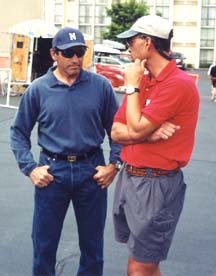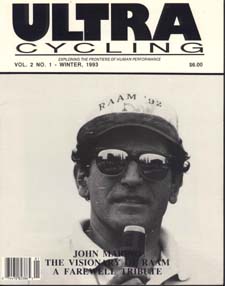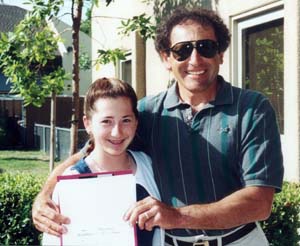“Without John’s vision and participation, I don’t believe RAAM would have ever evolved.” – Pete Penseyres
by Ed Fleming
About the Hall of Fame

John Marino and Lon Haldeman (John Hughes photo)
Where would ultra cycling be without John Marino? We’d probably still be thinking a 200 miler was long. Would there even be a RAAM? Maybe, but surely not a race of RAAM’s caliber. This cycling pioneer was the catalyst and driving influence behind what would eventually become known as the toughest race of any kind in the world – The Race Across America.
John Marino has always been an athlete. He was a star baseball and football player at Hollywood (CA) High School. The L.A. Dodgers pro baseball team drafted him twice while he attended San Diego State U, but John wanted to finish his teaching degree first. In the interim, he sustained a baseball career-ending back injury while lifting too much weight during training.
In the mid-’70s he met Gordon Smith who had developed an interesting system of learning. “Auto-Generational Acquisition Theory” dissected the reasons why people learn and outlined a creative methodology of learning. Since John was frustratedwith his baseball misfortunes, he wanted to pursue something in sports to test this theory.
“On a day in September ’76, I was feeling quite ambitious and began paging through the Guinness Book of World Records for a sport that I could do. I wanted to be in this book someday. I chose cycling and specifically the U.S. coast to coast record – Santa Monica City Hall to New York City Hall. I became a cycling fanatic for two years and in 1978 broke the Guinness Book record. That was new ground for me. I had taken on a task that I hadn’t a clue what to expect. Finishing that ride was the greatest thrill of my life.”
“After setting the record, I realized that the endeavor was more than a race. It was an expedition. It was more than merely pedaling a bicycle fast and long. It involved logistics, i.e., food, equipment, routing, weather, clothing, crewing, scheduling, sleep, driving, vehicles, safety, support from others, etc. It was incredibly interesting. There was so much about the challenge that could pique one’s interest. There was also much room for improvement in performance. I knew that events like this draw interest, they always have in the past and always will in the future. The event is an adventure. It’s also has an ‘off the wall’ quality. It’s just so ‘out there.’ This is really living life to the max. It’s not for everyone, but definitely a huge attraction to some. Bob Hustwit, a friend who helped set up the business part of RAAM and the WUCA often said, ‘If you create a sporting event that is believed to be the toughest and most grueling, people will stand in line to enter, and pay you to do it.'”
So, in 1982 John, along with Lon Haldeman, Michael Shermer and John Howard were the first to race bicycles across the United States in the “Great American Bike Race”.
“My initial thought was that racers would be closer together. In that first race, we were not ready for the complexities of tracking riders that were days apart. This became a filming nightmare. I finished way, way back. The race didn’t involve any “neck and neck” drama and I was positive that we were history. I thought that the whole thing was a mistake for ABC and everyone connected. After speaking on the phone to the producers at ABC, I changed my mind. Our finishing splits really didn’t matter to them. The fact that we all made it across the country, most notably Lon’s tremendous performance (and record), provided interest at all levels. They needed only a winner with an impressive time, and some human interest stories. The filming is what really offered legitimacy to our new event. If a major network shows interest in you, so will others. ABC was a valuable part of our initial growth. We were very fortunate to have them during our beginning years. Also, the producers presented award winning shows, which really helped.”

Farewell tribute to John Marino (Dave Nelson photo)
“Credibility for the race was finally achieved in RAAM ’85, specifically the Jonathan Boyer vs. Mike Secrest match-up. This was a defining moment in ultra-marathon cycling. Boyer entered the race as one of America’s greatest cyclists, a top ten finisher in the Tour de France. He was the consummate professional cyclist and was confident that no one else would “give him a race.” The bicycle racing community believed that the typical RAAM riders were merely tourists and not fast. Finally, a real racer was going to prove it. Boyer ended up winning; however, Mike Secrest with roots in ultra-marathon, matched him pedal for pedal and only lost by two hours. Boyer was totally surprised by this. He couldn’t shake Secrest. I watched him try for most of the race. If Secrest had not performed like he did, Boyer’s victory would have had resounding repercussions in the cycling industry. RAAM riders would have been totally discounted in the bike press, something they would have enjoyed doing. I really believe Secrest saved our reputation for many races to come. He proved that an ultra-marathoner has speed. Boyer was challenged big time and was humbled by Secrest.”
“Quite honestly, I’m not surprised that RAAM is still going strong after over 20 years. I can remember back in the early 80’s that ‘experts’ in the cycling industry believed that the only reason RAAM existed was because of ABC Sports. Our demise was believed to be just around the corner. Well, we lost ABC many years ago. It really didn’t matter much. During our RAAM reign, we’ve watched the end of several American classic bicycle races. We’re still here. An interesting aspect about ultra-marathon cycling is that the number of people that do it is relatively small, as compared to running marathons, triathlons, and some cycling events; however, the impact of these few cyclists is large. Our organization always remains at about 1200 members worldwide. In our sport, it’s not the quantity of entrants or cyclists; it’s the quality of the endeavor. Our sport has maintained organization and recognition for many. The WUCA is instrumental in unifying our sport, which will always draw in new people at all levels.”
“In our sport, it’s not the quantity of entrants or cyclists; it’s the quality of the endeavor.”
“For me, one of the brightest parts about RAAM and ultra cycling has always been the people. I have many fond memories of the friends I have made. Although I only see RAAM people (crews and riders) once per year, I feel a strong friendship. I suppose it’s because of the circumstances. I believe you get to know people better during ‘trying’ times. There are so many truly quality people involved in this sport. The many people who have volunteered their help to the race and me hold a special place in my heart. Through my RAAM affiliation, I had the opportunity to meet Eddy Merckx, Bernard Hinault, Greg Lemond, and Eric Heiden.”
John has had a huge impact on the ultra cycling community over the years.
Susan Notorangelo: “I rode the 600 km Hemet race for my qualifying to go to France in 1983 for Paris-Brest-Paris. It was one of the hardest things I have ever done. But I remember John being there for all the racers and crews.”

John and Lindsey
Pete Penseyres: “Without John’s vision and participation, I don’t believe RAAM would have ever evolved. He was responsible not only for inspiring me but he created the concept of a race. If he had not done that, there would likely have been more individual record attempts, but nothing like RAAM. When he pulled the Great American Bike Race together it gave me a reason to cross the country, and I was excited to be a part of the first RAAM in 1983. Without RAAM, I am certain that I would have been content to be a tourist, USCF road racer, commuter, and as my wife Joanne correctly points out, just another bad golfer.”
John, now 52, lives in Irvine, CA with his wife of 20 years, Joni and their two teenagers – Lindsey and John. He ended his direct involvement in RAAM in ’92. For the past 12 years, he’s been a self employed general contractor. John intends to “focus on my kids and be involved in their lives as much as possible until they move out. I want to keep building my business and venture into different areas of construction and property acquisition as I get older.” Many thanks John. Good luck.
